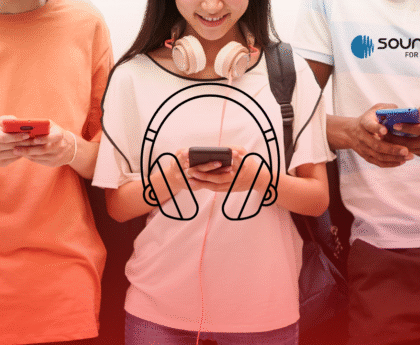Bluetooth hearing aids have transformed the way people with hearing loss communicate. These high-tech devices use both modern hearing technology and Bluetooth to connect wirelessly. Bluetooth hearing aids connect directly to your smartphone, TV, or other audio devices instead of using big cables or neck-worn streamers. With the Bluetooth connection you can listen to music, movies, phone calls, and more through your hearing aids without wires. Bluetooth hearing aids can make life much better for both seniors and young adults in India, where smartphones and streaming media are everywhere. This guide tells you how they work and shows you the best models that SFL Hearing Solutions, India’s top network of hearing clinics, has to offer.
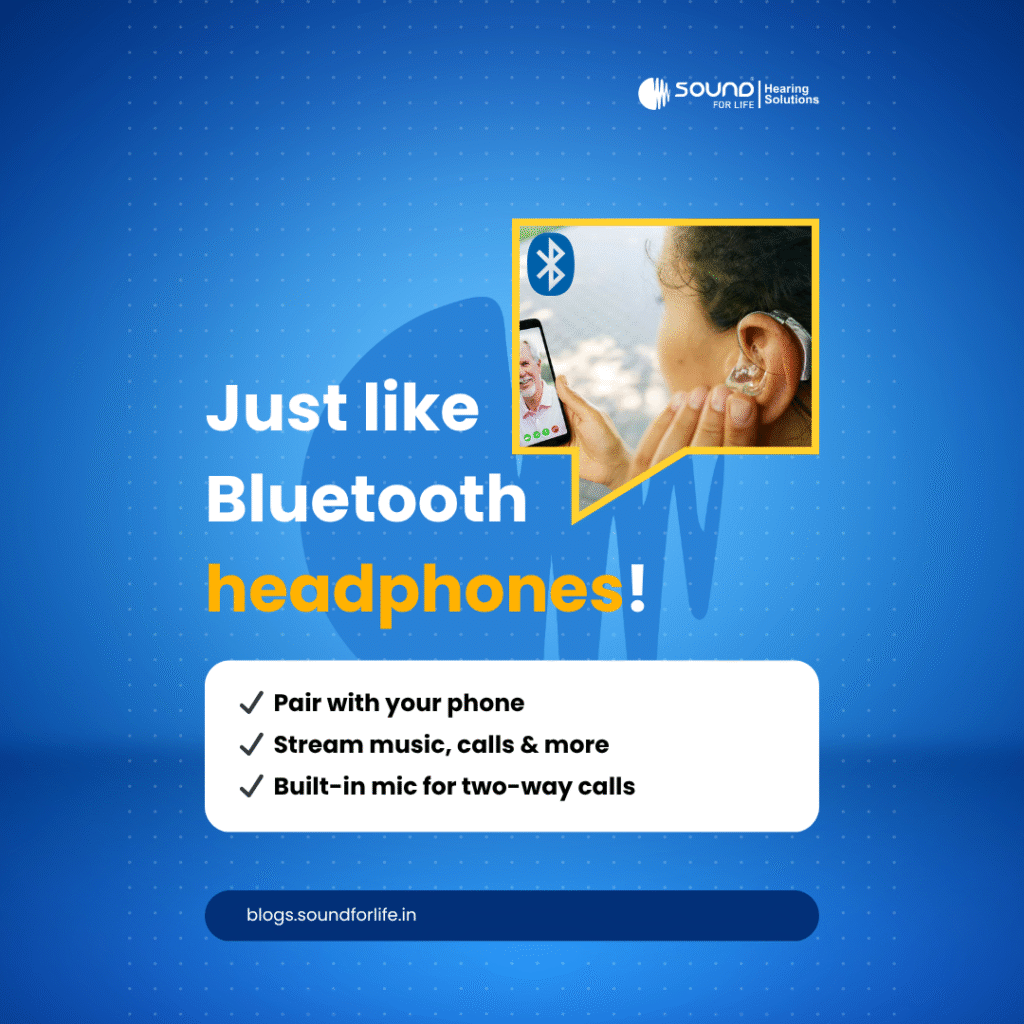
How Bluetooth hearing aids work
Bluetooth hearing aids work a lot like your Bluetooth headphones or earbuds. They have a small wireless radio inside that lets them connect to other devices. Here’s a simple way to look at it:
- Pairing with your phone or TV: To link your hearing aids to your phone or TV, switch on Bluetooth on your smartphone or tablet and then set the hearing aids to “pairing” mode. You may do this using the manufacturer’s app or by pushing a button on the device. The phone thinks the hearing aids are a Bluetooth audio device. After pairing, the hearing aid and phone remember each other and can connect again on their own later.
- Streaming audio wirelessly: Once the phone and hearing aids are paired, any sound that comes from the phone (calls, music, videos, etc.) is sent to the hearing aids over Bluetooth. The built-in processor in the hearing aids turns that wireless signal into sound that is tailored to your hearing loss. Your hearing aids turn into a headset that you don’t have to hold. You don’t need any extra accessories to talk on the phone or listen to music through your hearing aids.
- Bidirectional communication: Most Bluetooth hearing aids have a built-in microphone and a powerful processor that lets you hear what’s going on around you while you stream. The microphone in your hearing aid picks up your voice when you speak on the phone and sends it back through the phone. It is just like a standard headset call, there are no complications.
Bluetooth-enabled modern behind-the-ear (BTE) hearing aids can connect directly to smartphones and stream audio. The Phonak Naida Paradise (shown) is a BTE device that lets you make calls and listen to music without using your hands. Just like wireless earbuds, these hearing aids have a small Bluetooth chip inside. When you put them close to your phone and finish the pairing process, the phone’s sound is sent to both hearing aids at the same time. This lets you stream calls, songs, podcasts, TV shows, and more straight into your ears without any wires or extra gadgets.
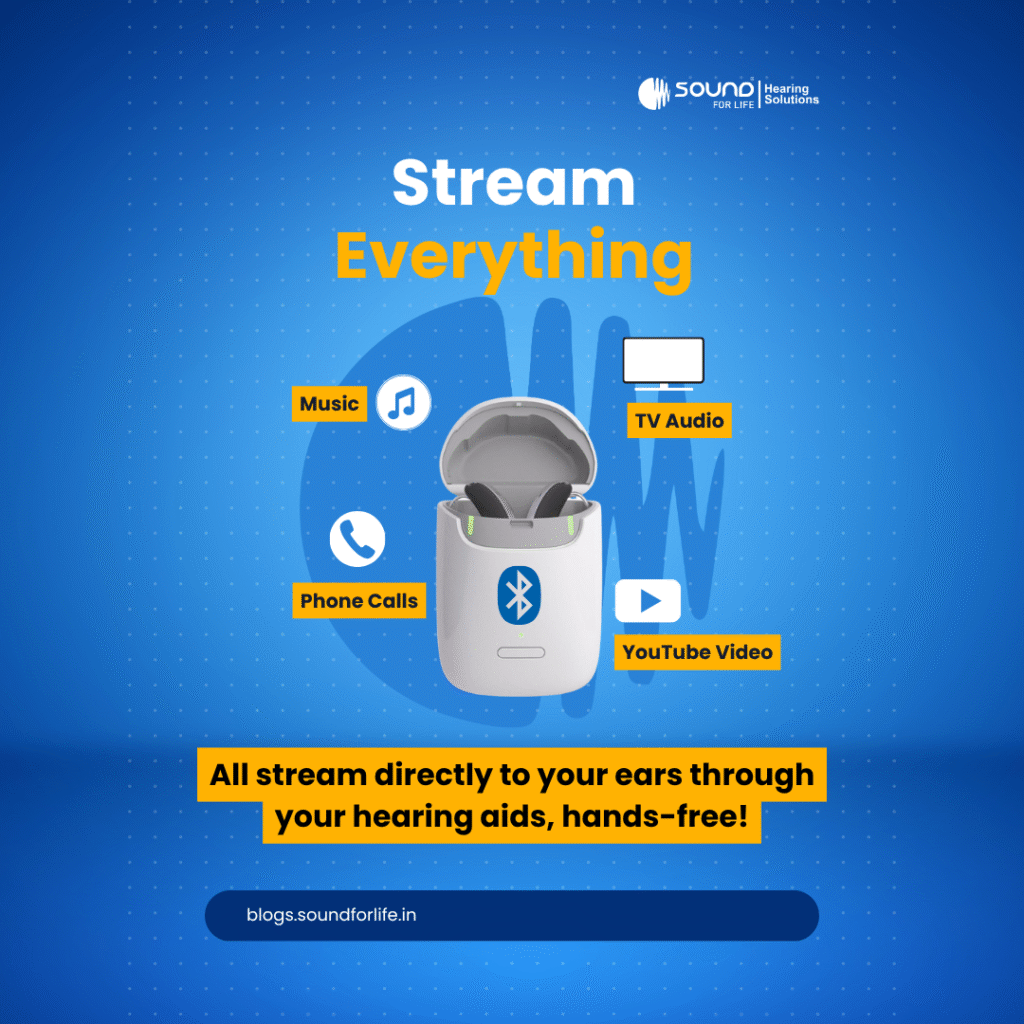
Important things to know about how Bluetooth hearing aids work:
- Direct connection: Newer hearing aids use standard wireless protocols, such as Bluetooth Low Energy for Audio, that let them connect directly to iPhones and many Android phones. Some older models needed a separate “streamer” device, but most modern aids don’t.
- Stereo Streaming: Sends audio to both ears at the same time, which makes it easier to hear and understand. Some hearing aids even use real binaural processing to make sure that the left and right devices work together to cut down on noises.
- Control via apps: After you connect, you can usually use a smartphone app (like the Phonak myPhonak app or the Signia app) to change the volume, switch programs or check the battery life. The app also uses Bluetooth to talk to the hearing aids.
- Energy efficiency: Bluetooth that doesn’t require a lot of power is used in hearing aids. Streaming does require more battery than regular usage, thus many Bluetooth-enabled hearing aids may be charged instead of thrown away.
In general, the technology works like any other wireless headset: you pair it once, and then your media and calls go through the hearing aids automatically. The aids’ built-in digital signal processing makes sure that the sound is tailored to your ears, which makes it as clear as possible.
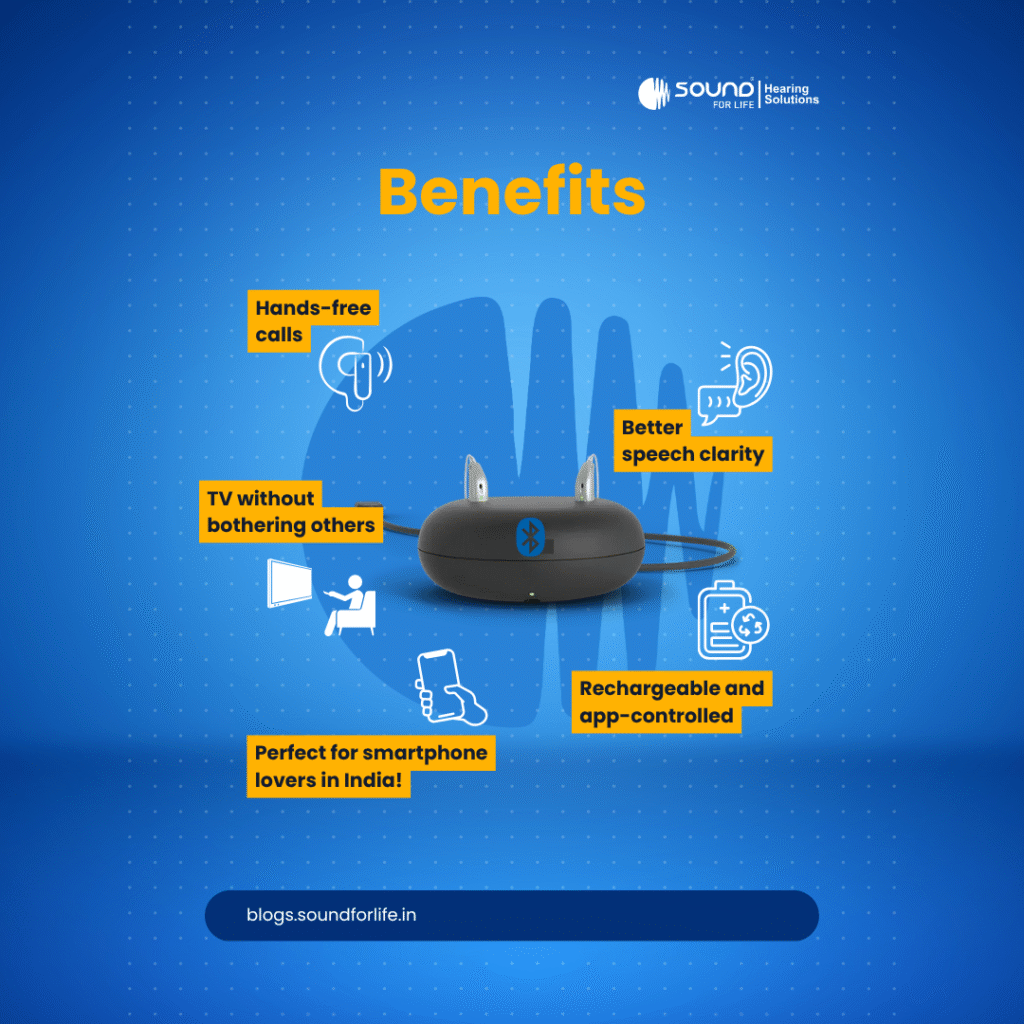
Benefits Bluetooth hearing aids
Hearing aids that work with Bluetooth have a lot of benefits over regular hearing aids. Some important benefits are:
- Hands-free phone calls and conferencing: You can answer calls on your phone or even on apps like WhatsApp and Zoom, and your hearing aids will let you hear the caller’s voice directly. You can also talk normally, and the hearing aids’ microphone picks up your voice clearly. This is great for older people who might have trouble holding a phone and for anyone who wants things to be easy.
- Direct music and media streaming: Listen to your favourite songs, podcasts, or videos with high-quality audio sent straight to your ears. This works with computers, tablets, TVs (if you have a compatible TV streamer), and of course smartphones. You don’t need loud outside speakers; you get clear, personal sound.
- Better TV and movie experience: It’s easier to watch TV in a loud room or with the sound turned down. Many hearing aids can connect to TV transmitters, and some can even connect to Smart TVs directly using Bluetooth. You can hear clear speech and change the volume to your liking without bothering others.
- Control and customization through apps: Apps let you control and change your hearing aid settings on the fly. You can change the volume, switch between listening programs (like “quiet room” or “outdoor”), or even do a quick hearing test, for example. Some apps also let you use the phone’s microphone to send sound to the hearing aids. This is great if you are far away from someone who is talking.
- Stereo sound and localisation: Streaming to both ears at the same time makes the sound clearer and easier to tell where it’s coming from. You can tell where sounds are coming from, which is especially useful in busy places or when talking to a lot of people.
- Convenience and discretion: No more cables or neck loops for convenience and privacy. Bluetooth hearing aids look and feel like regular hearing aids, but they have strong wireless features. They often come with hidden chargers so you can just put them in a case instead of messing with small batteries.
- Better hearing in noises: Many Bluetooth hearing aids have advanced features like AI algorithms and multi-microphone noise reduction. Even in a crowded room, streaming a clear phone call or using noise reduction can help you pay attention to the conversation.
- Multi-device connectivity: High-end hearing aids can connect to two devices at once, like your phone and your laptop. This lets you switch between them without any problems. You won’t miss a call on your phone even if you’re listening to music on your computer.
The Phonak Audeo Paradise is an example of a wireless, receiver-in-canal (RIC) style hearing aid that can also stream audio over Bluetooth. You only need to connect your aids to your smartphone’s Bluetooth menu once, and then calls and audio come right into your ears. This makes everyday things easier. For instance, you can watch TV with the volume up to normal without bothering other family members because the sound only goes to your ears. Even if you turn away from the TV, you’ll still be able to hear it clearly. This direct streaming is a game-changer for seniors and adults who are always on the go.
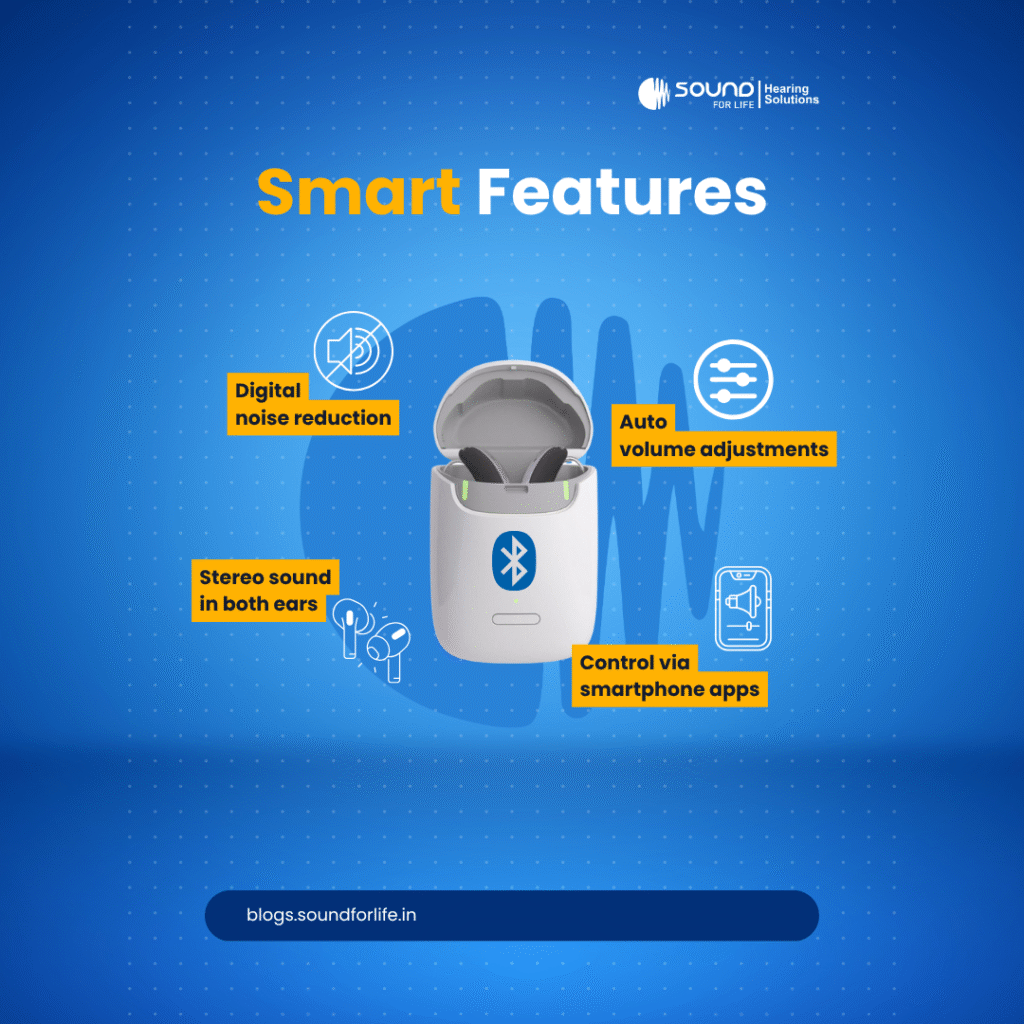
Here are some of the top benefits summarized in bullet form:
- Answering calls hands-free: You don’t have to lift the phone to your ear anymore; just answer on your hearing aids.
- Audio that is crystal clear: Stream music, podcasts, and videos in high quality, just like you would with headphones.
- Control with a smartphone app: You can easily change settings or switch modes with a phone app (many of which are free and easy to use).
- Dual connectivity: You can connect to two devices at once, like your phone and tablet, and switch between them without having to pair them again.
- Rechargeable Convenience: Most Bluetooth models come with a slim charging case, so you don’t have to deal with tiny batteries.
- Automatic program switching: Some hearing aids can tell what kind of sound is around them and switch programs, like going to “music” mode for streaming or “telecoil” mode for church.
Bluetooth hearing aids make it much easier to connect with the world by cutting the cords and letting you stream directly. These features are especially helpful for Indians who use smartphones a lot. Now your hearing aid is part of your smart-device ecosystem.
What to Look for When Buying a Bluetooth Hearing Aid?
When picking out a Bluetooth hearing aid, think about these things to make sure it will work for you:
- Compatibility (iOS & Android): Check to see if the hearing aid works with your phone (iOS and Android): Some are Made for iPhone (MFi), which means they work well with iPhones. Many newer ones also work directly with Android through technologies like ASHA or Bluetooth LE Audio, which is newer. Most of them let you stream audio from any Bluetooth source.
- Rechargeable vs. Battery: Rechargeable hearing aids (usually lithium-ion) are very easy to use. You just charge them every night like you do your phone. Some models still use disposable zinc-air batteries to make them even smaller, but you’ll have to change the batteries every week. Bluetooth accessories often prefer rechargeable ones because they make streaming easier.
- Water and Dust Resistance: If you can, look for an IP67 or IP68 rating, which means the device is splash, sweat, and dust proof. The weather in India can be humid, but a high-end hearing aid shouldn’t be ruined by sweat or rain.
- Noise-cancelling and directional microphones: Bluetooth hearing aids that are good still need to be able to hear conversations clearly. Most of them have advanced noise filters and directional microphones that help cut down on background noise. This is very important in busy places.
- Telecoil (T-coil): A telecoil can be useful if you go to places like temples, theatres, or government offices that have induction loop systems. The telecoil picks up sound from loop systems without wires. (Note: A T-coil is not Bluetooth, but a lot of modern aids have both.)
- Smartphone App: An app works with most Bluetooth hearing aids. Check to see if the manufacturer’s app has good reviews and is easy to use. You can change settings in the app without anyone knowing and see how much battery life you have left.
- Battery Life: See how long the aid lasts on a charge, especially when you’re streaming. Many say that each charge lasts 16 to 24 hours of listening time, depending on how you use them. If heavy streaming drains it faster, make sure the charging option works for you (some cases let you charge it multiple times while you’re on the go).
- Automatic vs. Manual: Some hearing aids change the volume and focus automatically depending on how loud it is. Some let you change modes by hand. Think about what you like best.
- Design and Comfort: There are many different styles of hearing aids, such as behind-the-ear (BTE) and completely-in-canal (CIC). The style can change the size and power of the battery. For instance, super-small CIC models might not always be able to use Bluetooth fully because they are too small. Most of the time, BTE or receiver-in-canal (RIC) styles have all the Bluetooth features. SFL’s audiologist can help you find a style that works for you.
- Brand Support and Trial: Because SFL is a specialist in many brands, choose a hearing aid from a well-known brand that has local support. SFL gives free trials and fitting services. Make sure the thing you choose has a good warranty and can be adjusted by a professional.
When picking out a Bluetooth hearing aid, you should think about the features you need and how much money you have. But the most important things are how well it fits and how good the sound is. You can try out these features and get hearing tests at SFL Hearing Solutions before you buy them.





